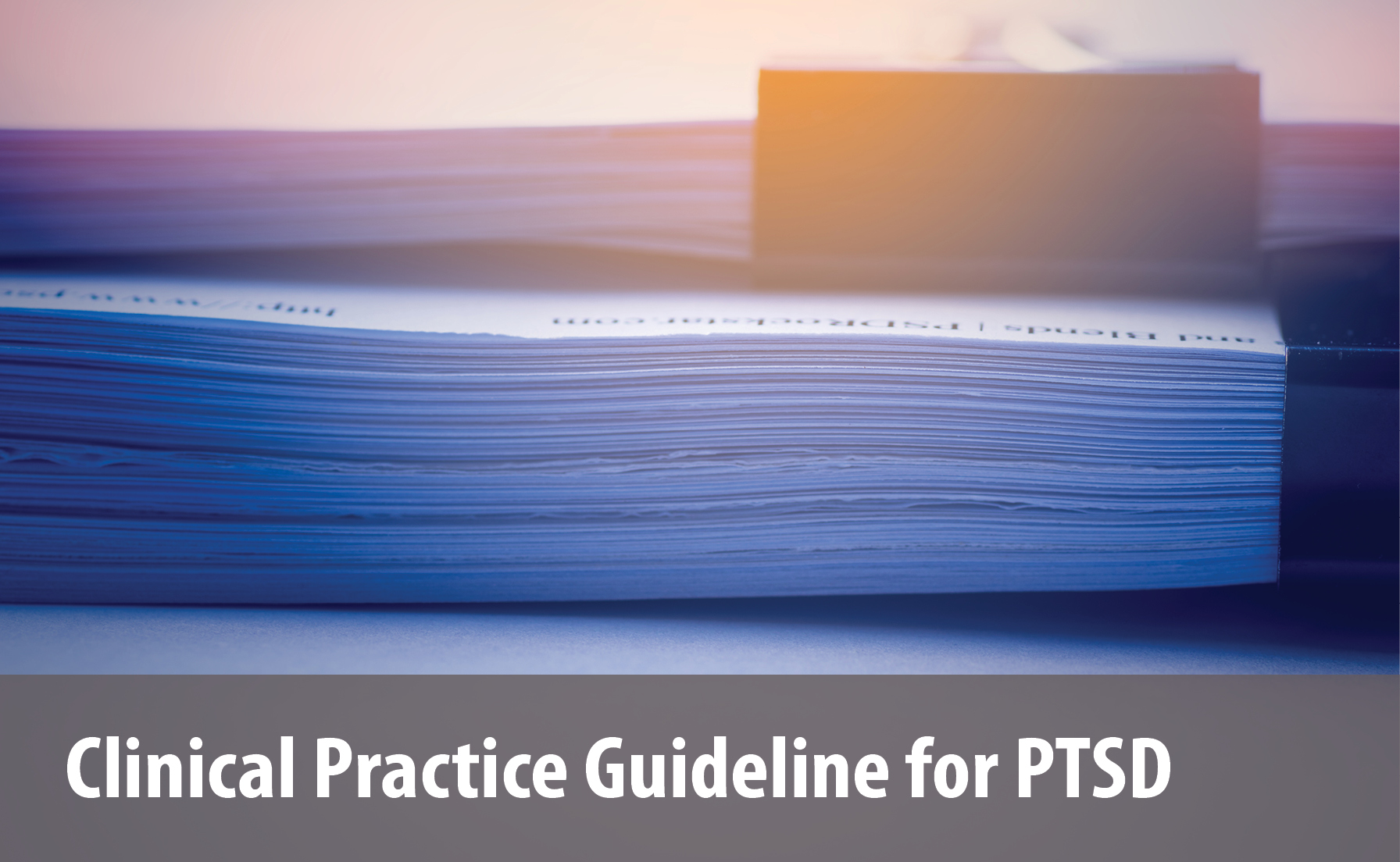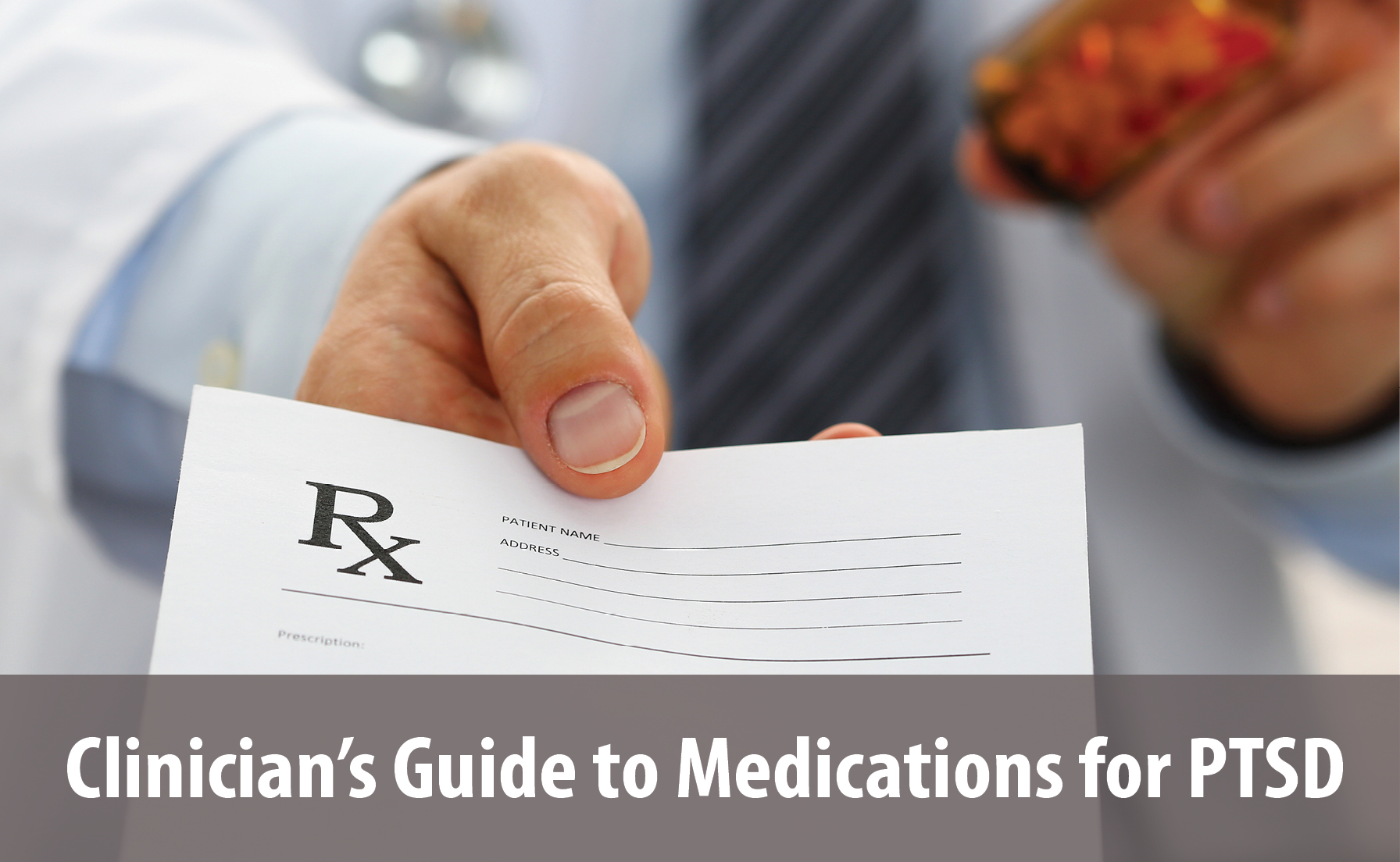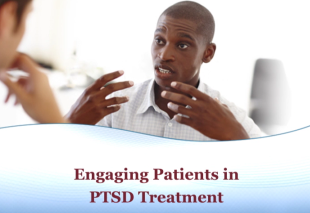PTSD: National Center for PTSD
Enhancing PTSD Treatment and Delivery
Enhancing PTSD Treatment and Delivery
Evidence-based treatments exist for PTSD. Most notably, the cognitive behavioral treatments of Cognitive Processing Therapy and Prolonged Exposure, as well as Eye Movement Desensitization and Reprocessing, have been identified in clinical practice guidelines as first-line treatments for PTSD (1-6). These treatments lead to successful outcomes in about half of all cases.
Still, clinicians and researchers are interested in finding new ways to advance PTSD treatment, accessibility, and delivery for certain populations and for patients who fail to respond to current evidence-based treatments. These advances include alternative delivery strategies, engagement strategies, combining treatments, and flexible applications of manualized treatments.
Continuing Education
How Do We Make Effective Psychotherapy for PTSD More Effective?
The course describes the relative effectiveness of PTSD treatment, emerging science in PTSD psychotherapy and strategies for enhancing treatment effectiveness.
In This Article
New Technologies
Virtual reality therapy
New technologies are being used to facilitate the delivery of effective treatments. One example is virtual reality therapy, which utilizes computer-generated simulation during exposure exercises to enhance activation of trauma memories and related emotions. This may be particularly helpful for patients who have difficulty visualizing or emotionally engaging with the trauma memory. Results of a small trial suggest virtual reality may reduce PTSD symptoms (7), but no trial has yet to compare virtual reality to imaginal or in vivo exposure.
Internet
Another way to enhance treatment accessibility is through the Internet. Therapist-assisted Internet treatments typically involve having patients access therapeutic materials online while receiving assignments and feedback from a therapist via computer. This mode of treatment is thought to be particularly useful for patients living in remote areas, patients with limited mobility, and those who fear stigma around seeking treatment. Results of several trials indicate that this modality is feasible, acceptable to patients, and effective for PTSD (8-10).
Videoconferencing
Videoconferencing is another alternative technological strategy for enhancing treatment accessibility. Treatment is delivered via live video camera so that the patient can still see and communicate with the therapist. This form of treatment delivery may be particularly helpful for those who may not otherwise attend treatment. Results of one study suggest that Veterans with PTSD tolerate and respond to telehealth interventions in a manner similar to traditional, in-person treatments (11).
Back to TopEngagement Techniques
Interest in motivational enhancement or engagement techniques has also recently burgeoned in the field of psychotherapy. These strategies might be particularly useful prior to delivering an evidence-based treatment, especially if patients do not appear motivated or ready to engage or make changes in their lives. The development of approaches such as PTSD Motivation Enhancement Group (12), Dialectical Behavior Therapy (13), and Acceptance and Commitment Therapy (14) are examples of innovations aimed at targeting specific processes in an attempt to enhance treatment participation and outcome.
Continuing Education
Engaging Patients in PTSD Treatment
This PTSD 101 online course describes and demonstrates recommended engagement strategies for providers who offer PTSD treatment (psychotherapy).
Combining Therapies
There is some research on the effects of combining psychotherapies to enhance treatment for patients who fail to respond to treatment adequately. For example, Prolonged Exposure (PE) has been compared to a combination of PE and Stress Inoculation Therapy (15) and to the combination of PE and cognitive restructuring (16). Imaginal exposure has been compared to imaginal exposure plus imagery rescripting (17), and exposure therapy has been compared to a combined treatment of exposure therapy followed by behavioral family therapy (18).
In all of these cases, the combined or added components did not enhance PTSD outcomes more than the stand-alone PTSD treatment, suggesting that the additional components were not necessary. Further, skills training has been delivered before PE to examine the effectiveness of the combined interventions (19). Indeed, the combination was effective compared to a wait-list control; yet the trial was not designed to examine whether the combined treatment performed better than PE alone.
Research findings related to combining psychotherapy with medication are mixed. Although Rothbaum and colleagues found that PE improved outcomes in partial responders to an SSRI (20), Simon and colleagues found that an SSRI did not improve outcomes in partial responders to PE (21). However, D-Cycloserine (DCS) may be one way to improve outcomes with exposure-based therapies. DCS is an NMDA receptor agonist thought to enhance extinction effects (22). Randomized controlled trials have demonstrated that DCS improves outcomes of exposure based treatments in patients with anxiety disorders such as specific phobia, social phobia, and obsessive compulsive disorder (22). Studies are underway in PTSD populations.
Flexible Delivery
Investigations are also underway to evaluate whether manualized treatments for PTSD can effectively be delivered flexibly outside the research setting. In one innovative study (23), community therapists were trained in a manualized cognitive behavioral therapy for PTSD, and the therapists were told they could use the manual flexibly. That is, therapists could add sessions or deviate from the manual. The researchers found comparable effect sizes of the flexible application to those found in a randomized control trial of the same intervention (19).
Conclusion
Evidence-based treatments exist for PTSD, yet they are not effective for everyone. As such, clinicians and researchers are interested in finding new ways to advance PTSD treatment, accessibility, and delivery. Novel technological developments show promise in feasibility and success, as do engagement strategies, D-cycloserine paired with exposure techniques, and flexible applications of manualized treatments.
References
- Australian Centre for Posttraumatic Mental Health. (2007). Australian guidelines for the treatment of adults with acute stress disorder and posttraumatic stress disorder. Melbourne, Victoria: Author.
- Foa, E. B., Keane, T.M., & Friedman, M.J. (2009). Effective treatments for PTSD: Practice guidelines from the International Society for Traumatic Stress Studies(1-388). New York: Guilford.
- National Collaborating Centre for Mental Health. (2005). Post-traumatic stress disorder: The management of PTSD in adults and children in primary and secondary care(1-167). London: Gaskell and the British Psychological Society.
- Ursano, R. J., Bell, C., Eth, S., Friedman, M. J., Norwood, A. E., & Pfefferbaum, B. (2004). Practice guideline for the treatment of patients with acute stress disorder and posttraumatic stress disorder [Special issue]. American Journal of Psychiatry, (Suppl), 161.
- VA/DoD Clinical Practice Guideline Working Group. (December 2003). Management of post-traumatic stress. Washington, DC: Veterans Health Administration, Department of Veterans Affairs and Health Affairs; Department of Defense; Office of Quality and Performance publication 10Q-CPG/PTSD-03.
- Institute of Medicine. (2008). Treatment of posttraumatic stress disorder: An assessment of the evidence. Washington, DC: The National Academies Press.
- Difede, J., Cukor, J., Jayasinghe, N., Patt, I., Jedel, S., Spielman, L. A., ...Hoffman, H. G. (2007). Virtual reality exposure therapy for the treatment of posttraumatic stress disorder following September 11, 2001. Journal of Clinical Psychiatry, 68, 1639-1647.
- Knaevelsrud, C., & Maercker, A. (2007). Internet-based treatment for PTSD reduces distress and facilitates the development of a strong therapeutic alliance: A randomized controlled clinical trial. BMC Psychiatry, 7, 13.
- Lange, A., Rietdijk, D., Hudcovicova, M., Van de Ven, J. Q. R., Schrieken, B., & Emmelkamp, P. M. G. (2003). Interapy: A controlled randomized trial of the standardized treatment of posttraumatic stress through the internet. Journal of Consulting and Clinical Psychology, 71, 901-909.
- Litz, B. T., Engel, C. C., Bryant, R. A., & Papa, A. A. (2007). A randomized, controlled proof-of-concept trial of an internet-based, therapist-assisted self-management treatment for posttraumatic stress disorder. American Journal of Psychiatry, 164, 1676-1683.
- Freuh, B. C., Monnier, J., Yim, E., Grubaugh, A. L., Hamner, M. B., & Knapp, R. A. (2007). A randomized trial of telepsychiatry for post-traumatic stress disorder. Journal of Telemedicine and Telecare, 13, 142-147.
- Murphy, R. T., Rosen, C. S., Cameron, R. P., & Thompson, K. E. (2002). Development of a group treatment for enhancing motivation to change PTSD symptoms. Cognitive and Behavioral Practice, 9, 308-316.
- Linehan, M. M. (1993). Cognitive Behavioral Treatment of Borderline Personality Disorder. New York: Guilford Press.
- Hayes, S., Strosahl, K., & Wilson, K. (1999). Acceptance and Commitment Therapy: An experimental approach to behavior change. New York: The Guilford Press.
- Foa, E. B., Dancu, C.V., Hembree, E. A., Jaycox, L.H., Meadows, E. A., & Street, G.P. (1999). A comparison of exposure therapy, stress inoculation training, and their combination for reducing posttraumatic stress disorder in female assault victims. Journal of Consulting and Clinical Psychology, 67, 194-200.
- Foa, E. B., Hembree, E. A., Cahill, S. P., Rauch, S. A. M., Riggs, D. S., & Feeny, N. C. (2005). Randomized trial of prolonged exposure for posttraumatic stress disorder with and without cognitive restructuring: Outcome at academic and community clinics. Journal of Consulting and Clinical Psychology, 73, 953-964.
- Arntz, A., Tiesema, M., & Kindt, M. (2007). Treatment of PTSD: A comparison of imaginal exposure with and without imagery rescripting. Journal of Behavioral Therapy and Experimental Psychiatry, 38, 345-370.
- Glynn, S. M., Eth, S., Randolph, E.T., Foy, D. W., Urbaitis, M., & Boxer, L. (1999). A test of behavioral family therapy to augment exposure for combat-related posttraumatic stress disorder. Journal of Consulting and Clinical Psychology, 67, 243-251.
- Cloitre, M., Koenen, K. C., Cohen, L.R., & Han, H. (2002). Skills training in affective and interpersonal regulation followed by exposure: A phase-based treatment for PTSD related to childhood abuse. Journal of Consulting and Clinical Psychology, 70, 1067-1074.
- Rothbaum, B. O., Cahill, S. P., Foa, E. B., Davidson, J. R. T., Compton, J. S., Connor, K. M., ...Hahn, C. (2006). Augmentation of sertraline with prolonged exposure in the treatment of posttraumatic stress disorder. Journal of Traumatic Stress, 19, 625-638.
- Simon, N. M., Connor, K. M., Lang, A. J., Rauch, S. A. M., Krulewicz, S., LeBeau, R. T., ...Pollack. M. H. (2008). Paroxetine CR augmentation for posttraumatic stress disorder refractory to prolonged exposure therapy. Journal of Clinical Psychiatry, 69, 400-405.
- Norberg, M. M., Krystal, J. H., & Tolin, D. F. (2008). A meta-analysis of D-Cycloserine and the facilitation of fear extinction and exposure therapy. Biological Psychiatry, 63, 1118-1126.
- Levitt, J. T., Malta, L. S., Martin, A., Davis, L., & Cloitre, M. (2007). The flexible application of a manualized treatment for PTSD symptoms and functional impairment related to the 9/11 World Trade Center attack. Behavioural Research and Therapy, 45, 1419-1433.
You May Also Be Interested In

VA/DoD Clinical Practice Guideline for PTSD (2023)
Get information on evidence-based treatment recommendations for PTSD.

Clinician's Guide to Medications for PTSD
Get key information and guidance on the best medications for PTSD.


























